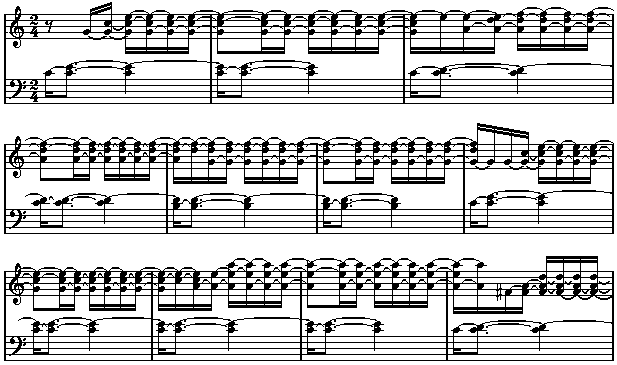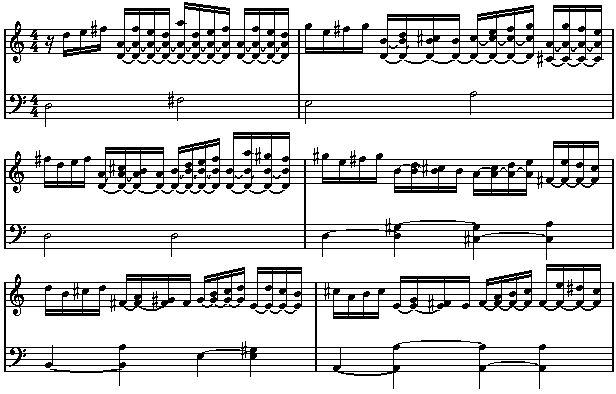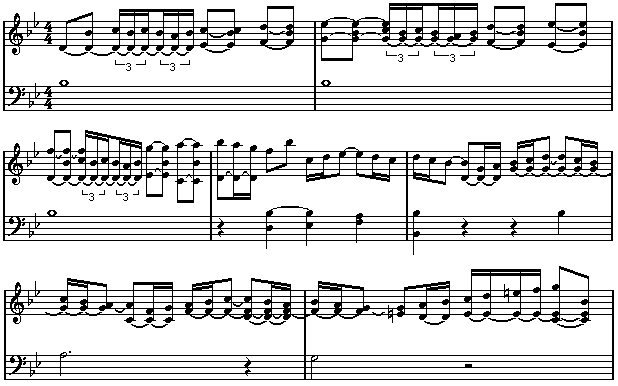
The first prelude, as written
Click here to hear it the way a computer scanner plays it
What could seem simpler: program a computer to read music and produce a MIDI sound file directly. No more hours practising scales!
Let's begin with the best - the Well-Tempered Klavier of Johann Sebastian Bach, whose publication in 1722 was selected by Life Magazine as one of the hundred key events of the past millennium:

The first prelude, as written
Click here to hear it the way a computer scanner plays it
Music notation was designed for people to read, not computers! As even François Couperin admitted, "we write differently from the way we play", adding that "there is an infinite distance between scores and good playing". And, Couperin was far more meticulous in his notation than others of his time.
Bach was renowned for his singing legato style on the harpsichord. If every detail of every note is precisely noted in a score exactly as Bach would have played it, it is far too complicated to read. But it sounds gorgeous! (In this and all following examples, the notation has been chosen to show sustains as clearly as possible - articulation, tempo changes, and other details have been removed for clarity.)

The same prelude, as it should be played on the harpsichord
Click here to hear it
Why am I sure Bach played like this? One often-quoted source - when Bach taught his wife Anna Magdalena Les Baricades Mistérieuses of François Couperin, she copied it like the first image above. Bach was renowned for his harpsichord playing in France - there is no room for doubt that he played it the way Couperin played and wrote it, in the style of the second image. Another is J.S.Bach's son C.P.E.Bach's introduction to his influential Essay on the True Art of Playing the Keyboard, "French music is always good to study ... all required embellishments are clearly indicated... nor is there any lack of held notes; these are fundamental elements of good performance". C.P.E.Bach's quotes are usually coupled with his statement that "in both composition and playing I had no teacher but my father".
There are many other historical writings that corroborate this meaning of this text. In the music of Rameau and F.Couperin, this style of playing was noted by a slur - "A slur over several notes means that one must hold them all down from one end of the slur to the other" (Rameau, 1724). However, the earlier the music, the less often such slurs were formally noted, even in France. There are few slurs marked in the keyboard music of Handel, yet, according to Charles Burney, Handel's touch "was so smooth, and the tone of the instrument so much cherished, that his fingers seemed to grow to the keys".
Of course, this prelude is an extreme case - most harpsichord music was not intended to be played this way! How can you tell what to sustain? My guide on the harpsichord is this:
if sustaining a note increases the sonority of the following notes, does not detract from their clarity, and is in accordance with the phrasing and tonality of the music, then sustain it.
This is a note-centered approach - the performer's task is to let each note speak for itself. Notes are born when written, but have life as long as they have something to say.
I must stress that this guide applies only to the harpsichord - organ and modern piano require a far more articulated touch than a harpsichord can use. Harpsichord sound is harmonic - strings can support each other against natural decay. Organ sound is continuously powered, piano sound is percussive not harmonic; in neither does each note have the life essence that a harpsichord gives. Passages in which successive notes form natural chords benefit from more sustain than melodic passages based on the human voice, which can sound only one note at a time. Dance music is naturally more articulated than pensive adagios or unmeasured preludes. Sustaining middle to low thirds, or low fifths, thickens the sound and is rarely suitable. Listen to K115 for a case where I consider them effective in adding richness to the sound.
Many long passages with no apparent rhythm may be brought to life with rhythmic sustains. For example, the 5th Prelude of the WTC is written as a mechanical stream of 16th notes, but is in fact a complex multi-level study in consonance:

The 5th prelude as it may be played
Click here to hear it
Phrasing of music was considered more important in the 18th century than it has been later on. Sustaining notes is an important component of good phrasing on the harpsichord. Bach's partitas provide many excellent examples:

The 1st partita as it may be played
Click here to hear it
The proper amount of sustain is very dependent upon the exact instrument, tuning and acoustical surroundings. Long before MIDI, I heard an unforgettable demonstration of this: in the 1950's Columbia released two sets of player-piano recordings, made with an early technique that recorded key velocity. The artists included most of the greatest players and composers of the time, ca. 1900. The first set was made on the original piano used for the recording and is a fascinating musical document. Then a marketer got control - the second set was played on "Artur Rubenstein's Steinway" and reduced those who had heard the original performers to tears. The bass overpowered the treble, the strings sustained far more, and the pedal wasn't adjusted the same - the best playing in the world became a cacophonous mush.
So, you must use the sound font made from my harpsichord to listen to my recordings. Anything else destroys the sound that is the essence of my playing, as does changing the tunings I used. It's particularly abusive to use a piano patch to play them. I know what a well played piano sounds like - I got a diploma in it. If you want to hear the sonatas on a piano, look for the recordings of Vladimir Horowitz - he did it right.
Since MIDI players have no provision for the effect that one harpsichord string has on other strings, I played pieces first on my real instrument, then adjusted my touch on the MIDI keyboard I recorded on until it sounded as similar as possible. These adjustments of course were strongly dependent on the tunings used, and to a lesser extent on the acoustical surroundings. Although my instrument is large, my music room was small, only 100 m3.
Study of continuous broken chord sounds, in Bach's concerti transcriptions for example, is a good way of listening to your instrument and its sensitivity to sustain.

part of BWV.980, after Vivaldi, as it may be played
Continuous sustain like this of notes above b4 on my instrument produces a barely audible sheen to the sound, around e4 makes the sound silvery in a similar way to a 4' stop. By a3 such sustains becomes a melodic element to the sound, and below c3 ('middle C') generally sound just heavy to thick. Your instrument will be different. With skilled composers such as Vivaldi, passages such as this progress up or down in pitch, and provide a natural shape to the sound; in passages by unimaginative composers, the performer has to work harder. Bach wrote out a bit of this type of sustain in the third movement of the published version of the Italian Concerto, as if it were two parts in tutti passages, the notational custom of the time.